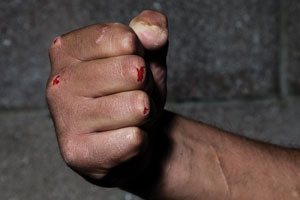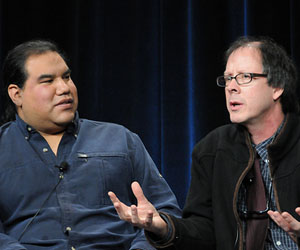
Matthew Rainwaters
IT TAKES A WHILE to notice Ruben’s scars. Though they’re hardly subtle, they don’t catch your eye as readily as his strong, smooth features or the big-ass smile that’s totally disarming despite his size: six foot three, 225 pounds. Neck like a waist. Friendly as you please. When I pointed to each of the healed-up gashes on his fists and asked what they were from, he replied, “Teeth. Teeth. These are all from teeth.” He charges $1,000 for every one that he knocks out of a person’s head. It’s the same price for each bone he breaks in a face, a practice that’s cost him a couple of knuckles.
The first people who hired Ruben, five years ago, were a regular, law-abiding couple from the Cherokee Nation who had been robbed, their savings snatched from under the mattress. The couple knew who’d stolen from them, but they couldn’t prove it, and they didn’t have any faith that the cops would take action. Ruben was a young Pawnee who had always gotten in a lot of fights and always seemed to win. He didn’t have anything against the guy; it was just a job, like his other odd jobs, roofing or tiling or cement work. He waited for the guy to walk out of a bar one night and started hitting him. Two facial fractures: eye socket and cheekbone. Two thousand dollars. Ruben—who’s asked me to use that name to protect his identity—says he can’t count how many times he’s played vigilante since then in the Indian nations of northeastern Oklahoma. Most often, it’s about stolen property. Sometimes, it’s about a raped sister or daughter.
“It’s about justice,” Ruben, 29, tells me when I say it doesn’t make any sense for victims to scrape together a pile of beating-up money after getting their cash stolen. “People want people either beat up or locked up. And on a reservation, they’re probably not gonna get anybody locked up.”
Statistically speaking, he’s probably right. The rate of violent crime among Native Americans is twice the national average (PDF); on some reservations, it’s 20 times higher. At least one in three American Indian women will be raped (PDF) in their lifetimes. Yet just 3,000 tribal and Bureau of Indian Affairs (BIA) officers—the only kinds of cops with jurisdiction on Indian land—patrol 56 million acres. In 2008, the Standing Rock Sioux Reservation in the Dakotas had nine officers for 9,000 people in an area twice the size of Delaware. (A typical town with the same population has three times that number.) Tribal courts can only prosecute misdemeanors such as petty theft and public intoxication. They can’t issue sentences longer than one year without meeting special criteria, and even then, three years is the maximum. More serious crimes must be handled by federal prosecutors, who turn down 65 percent (PDF) of the reservation cases referred to them.
Non-Indians commit two-thirds of violent crimes against Indians, including 86 percent of rapes and sexual assaults. Yet thanks to a 1978 Supreme Court ruling, tribes can not prosecute outsiders who commit crimes on their land. (The case involved a white guy who’d assaulted a tribal police officer and another who’d attempted a high-speed getaway from reservation cops.)
“Going out there was like trying to do your job with one hand tied behind your back,” says Damon Roughface, a former tribal police chief of White Eagle, in Oklahoma’s Ponca trust land. “People don’t care to report crime, because it’s just blowin’ wind. I’ll have to admit that sometimes people think the code of the street works a lot better than the BIA.” He points out that it’s not uncommon in poor communities, Indian and non-Indian alike, for people to develop their own mechanisms of enforcement. “But on reservations,” he says, “it’s only compounded by the BIA’s history.”
“Informal justice on reservations is motivated by the perception that they will not receive justice, usually. Or that justice will take too long, or that the system is corrupt,” says Jeffrey Ian Ross, an associate professor at the University of Baltimore’s School of Criminal Justice who studies Native Americans and the legal system. “In a system like that, there’s vigilante justice.” Melissa Tatum, associate director of the Indigenous Peoples Law and Policy Program at the University of Arizona, says reports of vigilantism aren’t unheard of in parts of Indian country beyond Oklahoma, though it’s hard to say how widespread it is. And some tribes, she notes, are successfully bypassing the courts in favor of traditional conflict resolution. But one element is constant: “There’s frustration with the jurisdictional maze on Indian territory,” says Carrie Garrow, a former St. Regis Mohawk Tribal Court judge and the executive director of the Center for Indigenous Law, Governance and Citizenship at Syracuse University.
That maze may not get more complex than it is in eastern Oklahoma, where Ruben and I drive past a series of signs announcing which Indian nation we’re entering —Osage, Otoe, Iowa, Sac and Fox, Pawnee, Ponca—and where the land is a checkerboard (PDF) of tribal and non-tribal ownership [Click here to see Melissa Tatum’s PDF chart of Indian Country jurisdiction]. County and tribal police sometimes agree to share jurisdiction over their mingled territory. But, as one Pawnee Tribal Police officer tells me, “They don’t go out of their way to patrol our areas, and we don’t really go in theirs.” Ruben’s been arrested dozens of times, but never, he says, on tribal land—simply because “the cops don’t come.”
Inside the Mint Bar in the town of Pawnee, the old men drinking draft beer at a big round table drop the phrase “those were the days” with almost comic frequency. One gestures above his head to a hole he once shot in the ceiling; the other guys instantly start pointing to the other bullet holes among the rafters. Nobody around here ever called the cops for nothin’, they say. If someone roughed up your property, or your gal, you came down to the bar and got someone to take care of it.
When we leave, I get in the driver’s seat of Ruben’s car; his license has been suspended for DUIs. His rap sheet extends far beyond that: breach of peace, first-degree robbery, obstructing an officer, aggravated assault. He’s never been arrested for a paid beating or done hard time for a regular fight, but he talks about how he should stop scrapping anyhow. He owes it to his kids. His ex has custody this week, but he talks to his five-year-old son and six-year-old daughter constantly on the phone. “You were the best player on that football team!” “I’m so proud of you doin’ good on that test! You’re going to be a spelling champion!” On the way back toward home in Osage Nation, he cracks into the 30-rack of Bud Light in the backseat and tells me how he landed a felony charge for assaulting an acquaintance who he felt was threatening his children.
He’s determined to provide his kids with a better example than he had. “My dad used to make me and my brother fistfight, and hit us with a two-by-four if we didn’t,” Ruben tells me when he’s more than a few cans deep. Caseworkers “would come to my house and ask me how’s my home life, if everything’s okay. But he’s right there in the same room. And what if I say no, and they don’t take me? So I said everything’s fine, and I would just pray that they’d see it behind my eyes: Get. Me. Outta here.”
We pull up to the house of two of Ruben’s friends, where the guys show off the driveway they poured today and the cabinet renovation they’ve done in the kitchen. They all talk about Indian loan-guarantee programs, and, as is often a topic of conversation, the various benefits different tribes give out. Ruben’s tribe, like most, isn’t one of those wealthy ones with casino revenues to distribute in abundance or invest in tribal services. A quarter of American Indians live below the poverty level; Ruben is on food stamps. His casino royalty check last year was for $8. “I’d rather they send a midget to my house to knock on the door,” he says, “and when I open it, have him punch me in the nuts and say, ‘Thanks for bein’ Pawnee.'”
His friends wince when we say we’ve been to White Eagle, where people keep telling Ruben he has no business taking a woman, much less a white woman. Where, Roughface told me, if a woman reports a rape to the BIA, “I guarantee you she’ll be revictimized.” Where the BIA recently shut down the entire tribal police department for incompetence. At four in the morning, a guy who’s even bigger than Ruben, parts Choctaw and Cherokee but nearly as pale as a Swede, pulls me aside and confesses he broke someone’s arm once. He’s not proud of it, but he needed the money, and anyway it was too expensive to hire a lawyer and the cops weren’t going to do anything about somebody not paying off a debt.
In July, President Obama signed the Tribal Law and Order Act (PDF) in the White House’s East Room. Standing beside him were two Indian men in headdresses, and Lisa Marie Iyotte, a Lakota woman whose rape case the feds had decided, without even interviewing her, not to pursue. (She couldn’t stop sobbing, even after Obama put his arm around her.) The act includes reforms like increasing tribal courts’ sentencing authority to three years—if they provide public defenders and trained judges. It mandates that tribal officers be instructed how to interview sexual-assault victims and collect evidence. It requires the Department of Justice to keep track of any Indian cases it declines to prosecute, and to gather more statistics on crime on Indian land. Obama called it “an important step to help the federal government better address the unique public safety challenges that confront tribal communities.”
Some Native American groups hailed the law, but not everyone is impressed. “The Indian communities have been longing for something for so long, they’re just willing to grab whatever right now,” says Virgil Wade, a criminal defender in Arizona’s Salt River Pima-Maricopa Indian Community. “I don’t know that it has the teeth that it’s gonna need.” Like, for example, the funds to pay for any of the proposed improvements—money the act doesn’t guarantee. “Right now, with the economy, everybody’s cutting back—tribes included.” Nor does the measure “bother to address the real problem, which is jurisdiction over whites,” says Syracuse’s Garrow. Tatum says she can’t be more than cautiously optimistic: “Endless bureaucracy and more data collection is a way of not dealing with a problem. And a lot of times, training gets mandated but never funded, and nothing happens with those mandates. It would not be uncommon to have requirements that just go by the wayside.”
Ruben’s also been thinking about reform. He talks about the importance of continuing the Indian way of life, and not just the way of the streets. “I know fighting isn’t the right way,” he tells me. He talks about his respect for one of his elder relatives, who showed him that not all Indians are drunks or fighters. But he’s also told me that he’d probably do a severe beatdown for just $500, and only last week he whipped an elbow across the face of a 19-year-old who’d disrespected him.
On my last night with Ruben, we head for a hill in Ponca City. There he stoops into his “church,” a cramped tent that serves as a sweat lodge, where he suffers hours of suffocating heat to give thanks for his people and his life, and to pray that he might do better in it.















